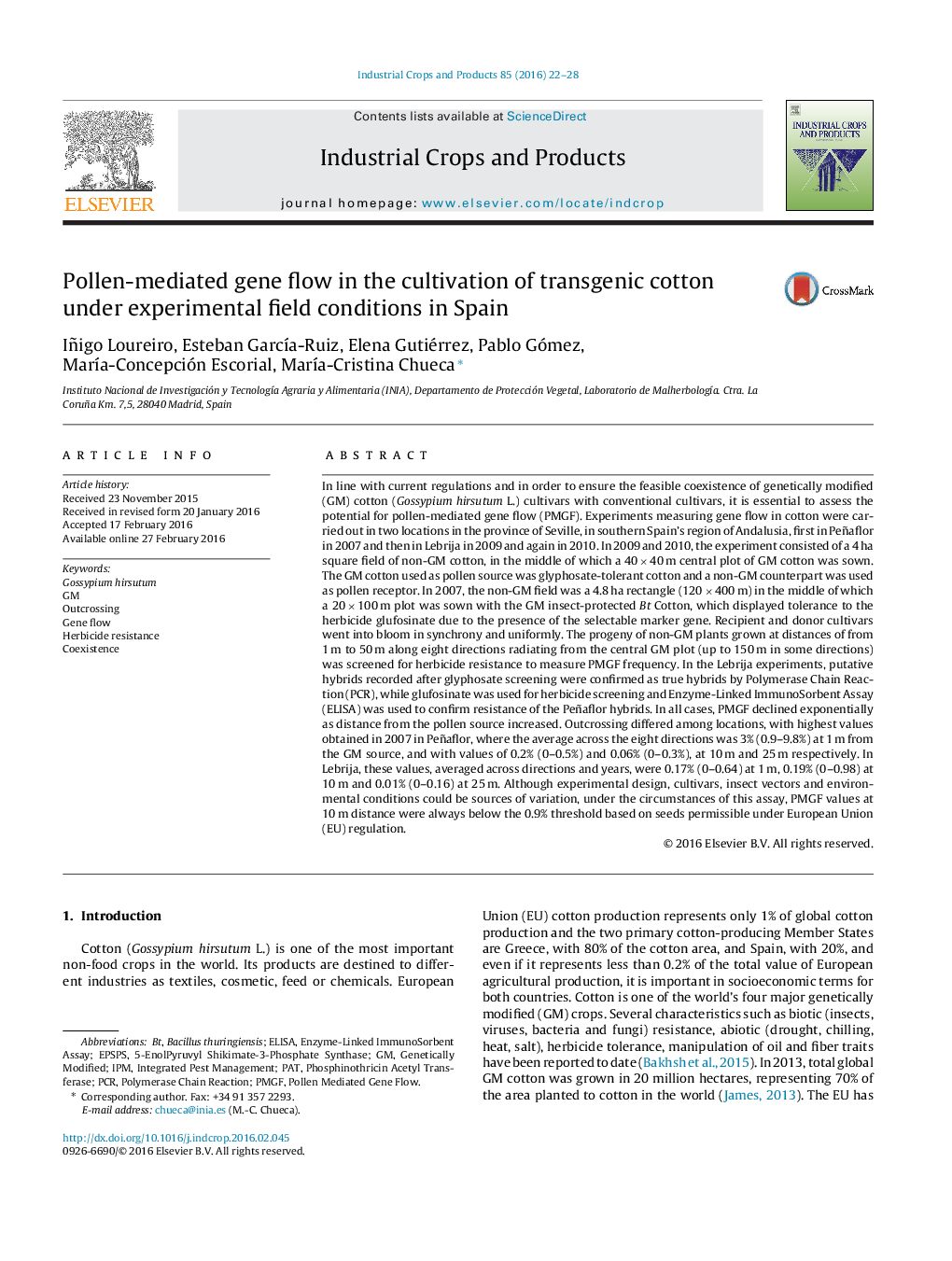| کد مقاله | کد نشریه | سال انتشار | مقاله انگلیسی | نسخه تمام متن |
|---|---|---|---|---|
| 4512486 | 1624825 | 2016 | 7 صفحه PDF | دانلود رایگان |
• Gene flow is important to determine the coexistence between GM and non-GM cotton.
• Pollen mediated gene flow (PMGF) study with GM cotton was first conducted in the EU.
• Field experiments were conducted in Andalusia, the Spain’s cotton major growing area.
• PMGF can be up to 9.8% in the non-GM cotton rows adjacent to the GM pollen source.
• PMGF rates were always below European Union 0.9% threshold at 10 m distance.
In line with current regulations and in order to ensure the feasible coexistence of genetically modified (GM) cotton (Gossypium hirsutum L.) cultivars with conventional cultivars, it is essential to assess the potential for pollen-mediated gene flow (PMGF). Experiments measuring gene flow in cotton were carried out in two locations in the province of Seville, in southern Spain’s region of Andalusia, first in Peñaflor in 2007 and then in Lebrija in 2009 and again in 2010. In 2009 and 2010, the experiment consisted of a 4 ha square field of non-GM cotton, in the middle of which a 40 × 40 m central plot of GM cotton was sown. The GM cotton used as pollen source was glyphosate-tolerant cotton and a non-GM counterpart was used as pollen receptor. In 2007, the non-GM field was a 4.8 ha rectangle (120 × 400 m) in the middle of which a 20 × 100 m plot was sown with the GM insect-protected Bt Cotton, which displayed tolerance to the herbicide glufosinate due to the presence of the selectable marker gene. Recipient and donor cultivars went into bloom in synchrony and uniformly. The progeny of non-GM plants grown at distances of from 1 m to 50 m along eight directions radiating from the central GM plot (up to 150 m in some directions) was screened for herbicide resistance to measure PMGF frequency. In the Lebrija experiments, putative hybrids recorded after glyphosate screening were confirmed as true hybrids by Polymerase Chain Reaction (PCR), while glufosinate was used for herbicide screening and Enzyme-Linked ImmunoSorbent Assay (ELISA) was used to confirm resistance of the Peñaflor hybrids. In all cases, PMGF declined exponentially as distance from the pollen source increased. Outcrossing differed among locations, with highest values obtained in 2007 in Peñaflor, where the average across the eight directions was 3% (0.9–9.8%) at 1 m from the GM source, and with values of 0.2% (0–0.5%) and 0.06% (0–0.3%), at 10 m and 25 m respectively. In Lebrija, these values, averaged across directions and years, were 0.17% (0–0.64) at 1 m, 0.19% (0–0.98) at 10 m and 0.01% (0–0.16) at 25 m. Although experimental design, cultivars, insect vectors and environmental conditions could be sources of variation, under the circumstances of this assay, PMGF values at 10 m distance were always below the 0.9% threshold based on seeds permissible under European Union (EU) regulation.
Journal: Industrial Crops and Products - Volume 85, July 2016, Pages 22–28
